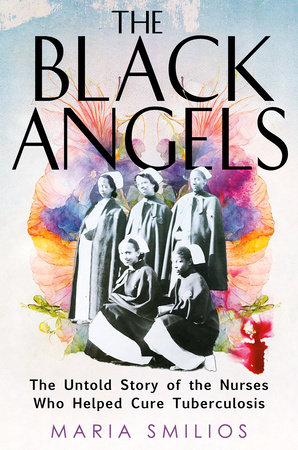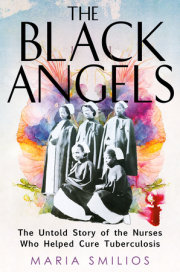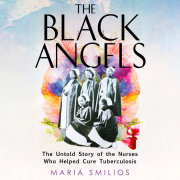Chapter 1The Call for NursesSpring 1929No one knew exactly how it started or who set it in motion, but in the spring of 1929, suddenly, inexorably, the white nurses at Sea View Hospital began quitting. One by one, they hung up their uniforms and walked out.
Their reasons varied. Many of them were weary of the long commute from Manhattan to Staten Island and the successive days of twelve-hour shifts; some cited the chronic mental and physical toll their job demanded. But most were leaving to escape tuberculosis-the Great White Plague, the robber of youth, the "Captain of the Men of Death"-and its victims: the infected incurable indigent consumptives. That's who came to Sea View, New York's largest municipal sanatorium.
On its floors, hundreds of patients lay in iron-frame beds, languishing, their bodies swarming with millions of arrogant microbes that gnawed at their lungs, kidneys, and tongues; their spines and bones and brains. All day long, they sweated and groaned and cried out; they coughed and choked and spit up blood, each hack sending flocks of live germs onto bedpans and sheets, tables, chairs, and doorknobs. The bacteria landed on walls and nightstands and window shades; it drifted under beds and down hallways, slinking into every room and corner of the ward. It was always present, swirling, lurking, waiting to strike anyone who wasn't already sick.
And all it took was a single inhalation.
Over the years, the nurses watched their colleagues fall ill. They saw how their faces turned ashen, how their eyes burned from a fever that climbed and climbed, and how their skin exuded a sickly odor that no amount of washing could eradicate. Some recovered, at least temporarily; others died in the wards where they once worked, mouthing, "God in Heaven," or "No, no, no," or nothing at all.
These days as the city thrummed and churned and grew, working white woman had plenty of options for jobs that wouldn't kill them: salesclerks, cashiers, stenographers, secretaries, librarians, and telephone operators who worked the switchboard at the New York Telephone Company's new headquarters, a soaring art deco skyscraper, the exact opposite of the dark and sprawling Sea View. As the weeks passed, the exodus at Sea View became impossible to ignore, and soon word reached the new commissioner of health, Shirley Wynne.
A dapper gentleman who was dedicated to his job, Wynne had reorganized the city's infectious disease hospitals and was currently focused on a massive public health campaign aimed at eliminating a different disease: diphtheria, a bacterial infection responsible for killing thousands of New York's children each year.
Months before, doctors had unveiled a vaccine, but previous mishaps with antidiphtheritic drugs had left parents hesitant to vaccinate their children. Frustrated, Wynne began marketing it "in the same manner as chewing gum, a second family car, or cigarettes." Leaflets announcing its safety were slipped in with phone bills; billboards and illustrated posters went up in Times Square; and "healthmobiles," renovated snow-removal trucks retrofitted with refrigerators to store the vaccine, fanned out into the neighborhoods; inside, a nurse fluent in each area's predominant language encouraged parents to vaccinate their children.
But the staffing shortage at Sea View presented Wynne with a different crisis, one healthmobiles and vaccines couldn't fix. Tuberculosis had no cure.
❖ ❖ ❖
Since the early 1900s, tuberculosis had haunted the city, finding willing hosts in the waves of immigrants arriving from all over Europe. With their cloth sacks and boxy suitcases wrapped tight with ropes and straps, they shuffled off liners with grand names like
RMS Olympic, Adriatic, and
Lusitania. Some headed to Brooklyn, Queens, and New Jersey, but many walked straight from the seaport to Manhattan’s Lower East Side, where they found lodging in the tenements.
Sprawling across a tangle of narrow streets and alleyways, where pigs and dogs and rats wandered beside humans, stood 80,000 five-story tenement buildings, collectively housing over two million people, then two-thirds of New York's population. These were dark places in dark times, havens of misery and despair, described by journalist Jacob Riis as "fever-breeding structures."
Inside them, narrow hallways lit by gas lamps led to tiny three-hundred-square-foot apartments where entire generations, sometimes ten to twelve people, lived shoulder to shoulder with scant fresh air and no indoor plumbing. During the day, the airless space was transformed into a workplace for punishing low-wage jobs: sewing buttons, shelling pecans, rolling cigarettes, and tying tags on clothing. At night, the people swept away the day's work and went to sleep, head to foot, four or five to a bed, or between chairs, or under tables. Some grabbed a blanket and curled up in the hallway or on the rickety stairwell, where mice and giant roaches skittered, upsetting the dust and droppings and cobwebs speckled with TB microbes.
City officials despised these tenement blocks, full of buildings with names instead of addresses-the Morgue, the Bucket, the Ink Pot-but social reformers and progressives loved them. Here they found their cause. Young rabble-rousing journalists, hoping to stop the spread of disease and raise public awareness, immersed themselves in tenement life, observing and engaging with the residents.
In "Lung Alley," a one-block stretch of buildings where over four thousand people, mainly immigrants, lived alongside dogs, cats, parrots, and a wizened old monkey, muckracking journalist Ernest Poole counted over four hundred babies scattered in the halls and courts and on the stairwells and fire escapes. He described it as "the locus of disease," a place unfit for human life. Here, Poole noted, people choked and died in the "foul air, darkness and filth" that fed "the living germs of the Great White Plague [tuberculosis]"; it did, he said, "great business."
He published his findings in a short book,
The Plague in Its Stronghold. The slim edition, with its stories of immigrants who came hoping for a better life but instead found themselves in a neighborhood overrun by "the Plague of all plagues," drew the attention of the press and Dr. Hermann Biggs, the general medical officer for New York City's Department of Health.
An expert in bacteriology and pathology, Biggs had already prevented the spread of cholera and meningitis in the city, but it was tuberculosis he longed to conquer. After studying it under Dr. Robert Koch-the German country doctor who in 1882 discovered that the cause of TB was the pathogen Mycobacterium tuberculosis-Biggs knew its power and stealth and malevolence.
This was an ancient evil, one of humankind's oldest. Some believed it reached back thousands of years to the ancient Egyptians, making it "the first-born of the mother of pestilence." Since then, it had consumed tens of millions of bodies.
But whatever spawned it and wherever it came from, Biggs wasn't interested. He was concerned with the people who coughed and spit up green and yellow phlegm or clots shaped like tiny ropes, who with each heave pitched the bacteria in irreverent ways all over the city. He loathed them and the disease they harbored and vowed to eradicate both.
Society, he said, held the "power to completely wipe out pulmonary tuberculosis in a single generation." It was a lofty claim, almost absurd, about a disease whose kill rate was one in seven. But Biggs, known for his iron will, wasn't deterred.
First, he reclassified TB as an infectious and "communicable disease caused by a germ." With the new terminology, he politicized it and instituted draconian measures, starting with the Registration Law, a decree ordering doctors and nurses to report the names and addresses of every person sick with tuberculosis to the Metropolitan Board of Health. Protests erupted: doctors argued it was dictatorial, taking away their authority, and patients said it invaded their privacy. Biggs didn't care. He continued collecting the information and tallying it on a city map by marking each infected apartment with a black dot. Soon a pattern emerged: on the Lower East Side and in Harlem, areas the city considered hotbeds of disease, black dots punctuated building after building, blotting out entire floors. Biggs's emerging disease graphic proved how TB could be "counted, tracked, evaluated, and combated."
With the data from the disease maps, he secured city funding and convinced officials that social control, namely of the poor, was possible. Then he went public, embarking on a radical campaign where he declared a "war on tuberculosis." This introduced a new narrative for the disease, one that would last for decades and justify using a germ to engage in social and racial warfare.
Biggs began his "war" by recommending that hospitals cordon off entire wards for TB patients and that the city establish free clinics devoted to treating the disease. Open-air schools were commissioned, tent colonies were erected in parks and along the river, and barges were turned into day camps for TB-afflicted children. Men were directed to shave off their beards and mustaches, an appalling prospect for many, who perceived them as a sign of power and dignity. Biggs cared little for social mores. To him, those thick tufts of facial hair were prime places for bacteria to congregate, a hypothesis not rooted in science and later debunked. Nevertheless, barbershops filled, and the mustaches and beards came off.
On streetcars and billboards, big bold posters went up, their messages couched in his rhetoric of war: "The Fight Against TB," "The Crusade," "The Enemy." There were exhibits, radio broadcasts, novels, mass mailings, and pamphlets titled
Warfare Against Consumption and
Tuberculosis that were printed by the thousands and distributed in tenements, libraries, insurance company offices, and railroad stations. Publicity blitzes included plays written and scheduled for performance during "Tuberculosis Week," and a lawyer named A. J. Schneeman donned a clown costume and called himself Chew Chew, New York City's "health clown." In his tailcoat, polka-dot pants, and oversize shoes, Chew Chew, along with Creamo, his health-dog sidekick, sang ditties about bathing and drinking milk and opening windows to children living in the slums.
Still, the dots on the disease map kept multiplying, exasperating Biggs.
In 1903, he met with city officials and explained that to win this "war," the sick, those he regarded as "indigent consumptives" and morally bereft spreaders of disease, must be quarantined far away from Manhattan; otherwise the disease would keep spreading, becoming an epidemic. After tapping into their collective disdain for the immigrants, the Black population, and the lower classes, Biggs turned to their real concern: economics, the dollars-and-cents cost of tuberculosis.
The market price for human life "at which tubercular deaths occur," he said, "is worth to the municipality $1,500."
With ten thousand people a year dying, the annual loss of labor and productivity amounted to $15 million, and according to his TB registry, the average patient remained sick for nine months, costing the city $2.50 a day in lost revenue and care.
Biggs let them absorb the figures. Then he wrapped up his economics of human life: for the 270 days consumptives spent dying, the city lost $8 million, resulting in an annual loss of $23 million-roughly $700 million in today's dollars.
Laid out in these terms, devoid of sentimentality or humanity, the raw figures seemed staggering, an unnecessary waste of money, especially for people they perceived as "ignorant" and expendable. Biggs finished by imploring officials to build a TB hospital as a "necessary protection for those who don't have [TB] but are exposed to it by the carelessness of patients."
The city obliged, and on a brisk November day in 1913, the commissioner of charities, Michael Drummond, cut the ribbon and officially inaugurated Sea View. It was, he said, "a vast, ingenious... sanitary" institution, built for the sick to find warmth and comfort, rest and strength to return to their lives. But if recovery failed, Drummond hoped that God would help them "in these beautiful surroundings to prepare for the greater house of many mansions." On the first day, eight hundred people were admitted, and from there the number kept climbing. Biggs's vision was working. By 1920, the annual TB death rate in New York had dropped by almost half, from ten thousand to a little more than five thousand.
But there it stalled.
❖ ❖ ❖
Now, in 1929, at the end of what some considered a magnificent decade, the nurses were leaving the dream hospital, and Sea View’s triumph had become Commissioner Wynne’s nightmare: tuberculosis remained the third leading killer in the city and the fourth globally. Someone suggested transferring the patients, but that was impossible-at the moment, a powerful flu was surging through the boroughs, filling the other twenty-six municipal hospitals to capacity. If Wynne couldn’t find nurses to staff Sea View, he would need to start closing wards, and hundreds of highly contagious TB patients in various stages of illness would converge on the city: the bedbound would go home or find a shelter or street corner and eventually die; the others, who were still ambulatory, would wander through the bustling sidewalks, ride the trains and trolleys, enter bakeries and delis and taverns, their coughs flinging active bacilli into the air like pieces of confetti. Infection rates would rise and decades of progress against the longtime killer would be reversed.
Wynne wouldn't let that happen. Sea View could not close. The white nurses needed to be replaced immediately, but how and with whom were the questions.
For years, the city had grappled with a borough-wide nursing shortage caused by World War I, when droves of nurses left New York hospitals to serve on the front lines in Europe. Afterward, their ranks had never quite recovered. Wynne called emergency meetings, spending hours consulting with health officials and infectious disease experts, and gradually an idea emerged.
For the past several years, major industrial cities in the North-Chicago, Detroit, Philadelphia, and New York-had solved the problem of labor shortages by issuing hiring calls across the South. Appealing to Black sharecroppers and farmers, recruiters in fancy suits had traveled to states like Georgia, Mississippi, South Carolina, Alabama, and Tennessee with pamphlets and promises of steady work, decent pay, and housing. They made the slaughterhouses, steel mills, and factories look appealing, and millions of Black southerners, hoping to escape the strictures of Jim Crow and the agricultural curses of drought and weeds and insects, had heeded the summons. In New York City, the steady stream of newcomers had almost doubled the Black population from 152,000 in 1920 to almost 327,000 in 1929.
Nursing wasn't factory work. It required more knowledge and training, but maybe the city could accomplish something comparable. Across the country, hundreds of trained Black nurses were qualified yet un- or underemployed. The city could offer them a package: Free schooling, if necessary, at Harlem Hospital School of Nursing. On-the-job training. Housing. A salary. And above all, as they saw it, a "rare opportunity" to work at one of New York City's integrated municipal hospitals. At the time, only four of the twenty-six city hospitals employed Black nurses-Harlem, Lincoln, Riverside, and, yes, Sea View, where most of the nursing staff was still white, although their numbers were dwindling. The solution wasn't ideal, but a shortage was a shortage, and history had proved this idea could work.
The call went out. Advertisements appeared in Black newspapers and on church bulletin boards. Recruiters from New York showed up at historically Black Colleges, Tuskegee, St. Phillips Nursing School, Hampton, and Howard University. In the hallways, college lounges, and infirmaries, Black student nurses read about the chance for a career in New York City. News spread by word of mouth, moving down the eastern seaboard, across the Mason-Dixon line through Virginia, Tennessee, the Carolinas, deeper into the American south. Until one summer day it arrived in Savannah, Georgia at the home of a preacher’s daughter.
Copyright © 2023 by Maria Smilios. All rights reserved. No part of this excerpt may be reproduced or reprinted without permission in writing from the publisher.








